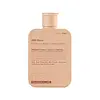What's inside
What's inside
 Key Ingredients
Key Ingredients

 Benefits
Benefits

 Concerns
Concerns

 Ingredients Side-by-side
Ingredients Side-by-side

Water
Skin ConditioningCocos Nucifera Oil
MaskingCream
EmollientGlyceryl Stearate
EmollientPEG-100 Stearate
Butyrospermum Parkii Butter
Skin ConditioningCaprylic/Capric Triglyceride
MaskingYogurt
Skin ProtectingNiacinamide
SmoothingAvena Sativa Kernel Oil
Skin ConditioningBetaine
HumectantPropanediol
SolventCetyl Alcohol
EmollientLactic Acid
BufferingPolysorbate 20
EmulsifyingGlycerin
HumectantTriethanolamine
BufferingPotassium Sorbate
PreservativeSodium Benzoate
MaskingAllantoin
Skin ConditioningSalicylic Acid
MaskingSodium Gluconate
Skin ConditioningAcetyl Hexapeptide-8
HumectantCaprylyl Glycol
EmollientParfum
MaskingWater, Cocos Nucifera Oil, Cream, Glyceryl Stearate, PEG-100 Stearate, Butyrospermum Parkii Butter, Caprylic/Capric Triglyceride, Yogurt, Niacinamide, Avena Sativa Kernel Oil, Betaine, Propanediol, Cetyl Alcohol, Lactic Acid, Polysorbate 20, Glycerin, Triethanolamine, Potassium Sorbate, Sodium Benzoate, Allantoin, Salicylic Acid, Sodium Gluconate, Acetyl Hexapeptide-8, Caprylyl Glycol, Parfum
Water
Skin ConditioningCocamidopropyl Betaine
CleansingGlycerin
HumectantDecyl Glucoside
CleansingDisodium Cocoyl Glutamate
CleansingTriethanolamine
BufferingPanthenol
Skin ConditioningLaminaria Digitata Extract
Skin ProtectingCetyl-Pg Hydroxyethyl Palmitamide
Skin ConditioningCeramide EOP
Skin ConditioningCeramide Ns
Skin ConditioningCeramide NP
Skin ConditioningCeramide As
Skin ConditioningCeramide AP
Skin ConditioningSodium Hyaluronate
HumectantOryza Sativa Bran Water
MaskingLactobacillus
Skin ConditioningMaltodextrin
AbsorbentCocos Nucifera Oil
MaskingSimmondsia Chinensis Seed Oil
EmollientPEG-40 Hydrogenated Castor Oil
EmulsifyingCitric Acid
BufferingTocopheryl Acetate
AntioxidantAcrylates/C10-30 Alkyl Acrylate Crosspolymer
Emulsion StabilisingXanthan Gum
EmulsifyingDisodium EDTA
Benzyl Alcohol
PerfumingEthylhexylglycerin
Skin ConditioningTocopherol
AntioxidantWater, Cocamidopropyl Betaine, Glycerin, Decyl Glucoside, Disodium Cocoyl Glutamate, Triethanolamine, Panthenol, Laminaria Digitata Extract, Cetyl-Pg Hydroxyethyl Palmitamide, Ceramide EOP, Ceramide Ns, Ceramide NP, Ceramide As, Ceramide AP, Sodium Hyaluronate, Oryza Sativa Bran Water, Lactobacillus, Maltodextrin, Cocos Nucifera Oil, Simmondsia Chinensis Seed Oil, PEG-40 Hydrogenated Castor Oil, Citric Acid, Tocopheryl Acetate, Acrylates/C10-30 Alkyl Acrylate Crosspolymer, Xanthan Gum, Disodium EDTA, Benzyl Alcohol, Ethylhexylglycerin, Tocopherol
 Reviews
Reviews

Ingredients Explained
These ingredients are found in both products.
Ingredients higher up in an ingredient list are typically present in a larger amount.
Cocos Nucifera Oil is obtained from the kernels of the coconut fruit. In other words, this is coconut oil.
Coconut Oil is rich in fatty acids with lauric acid making up the majority of these. It also contains linoleic acid. Due to this high fatty acid content, coconut oil helps trap moisture and soften skin.
Despite being antibacterial, coconut oil may not be great for acne-prone skin. It is comedogenic and may clog pores. This ingredient may not be safe for malassezia or fungal acne.
Note: Coconut Oil should not replace your sunscreen for UV protection. Studies show it only blocks about 20% of UV.
This oil is non-volatile and has a light scent.
The term 'fragrance' is not regulated in many countries. In many cases, it is up to the brand to define this term. For instance, many brands choose to label themselves as "fragrance-free" because they are not using synthetic fragrances. However, their products may still contain ingredients such as essential oils that are considered a fragrance.
Learn more about Cocos Nucifera OilGlycerin is already naturally found in your skin. It helps moisturize and protect your skin.
A study from 2016 found glycerin to be more effective as a humectant than AHAs and hyaluronic acid.
As a humectant, it helps the skin stay hydrated by pulling moisture to your skin. The low molecular weight of glycerin allows it to pull moisture into the deeper layers of your skin.
Hydrated skin improves your skin barrier; Your skin barrier helps protect against irritants and bacteria.
Glycerin has also been found to have antimicrobial and antiviral properties. Due to these properties, glycerin is often used in wound and burn treatments.
In cosmetics, glycerin is usually derived from plants such as soybean or palm. However, it can also be sourced from animals, such as tallow or animal fat.
This ingredient is organic, colorless, odorless, and non-toxic.
Glycerin is the name for this ingredient in American English. British English uses Glycerol/Glycerine.
Learn more about GlycerinTriethanolamine is an emulsifier and pH adjuster. It is created using ethylene oxide and ammonia. This gives Triethanolamine a nitrogen core and a similar scent to ammonia.
As an emulsifier, it prevents ingredients from separating and enhances texture by adding volume to a product.
PH adjusters are common in cosmetic products. The pH of a product can affect the effectiveness of other ingredients. A product with a high pH may also irritate the skin.
Learn more about TriethanolamineWater. It's the most common cosmetic ingredient of all. You'll usually see it at the top of ingredient lists, meaning that it makes up the largest part of the product.
So why is it so popular? Water most often acts as a solvent - this means that it helps dissolve other ingredients into the formulation.
You'll also recognize water as that liquid we all need to stay alive. If you see this, drink a glass of water. Stay hydrated!
Learn more about Water